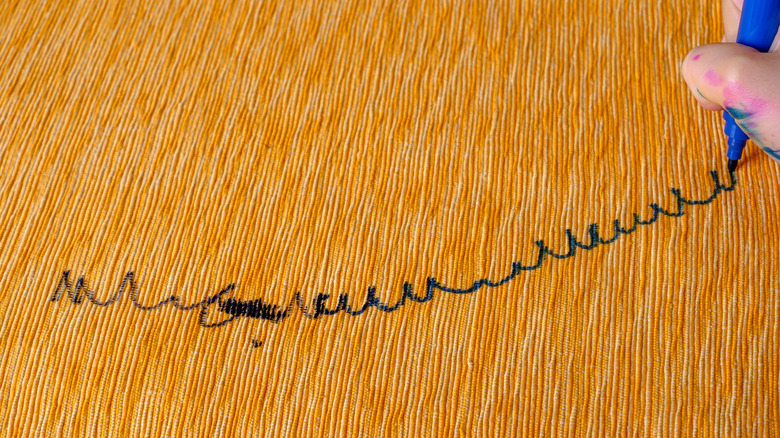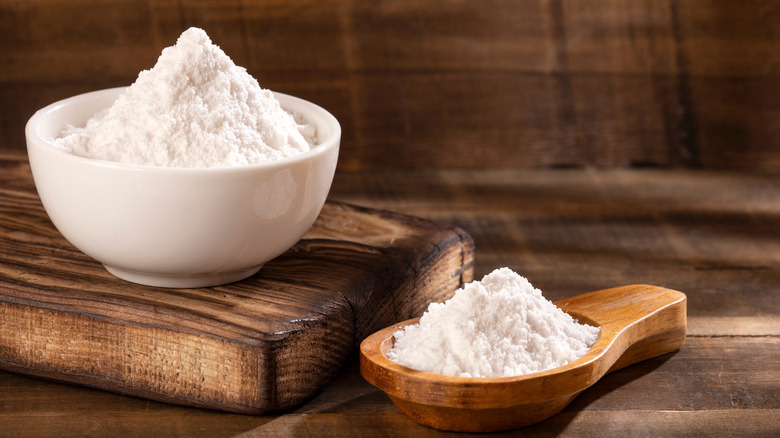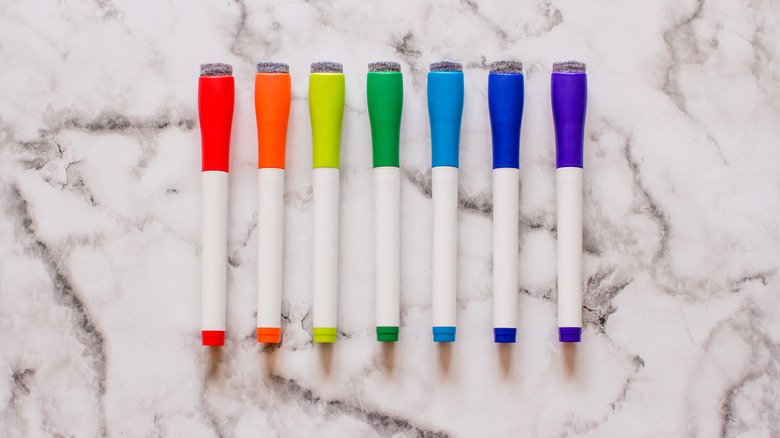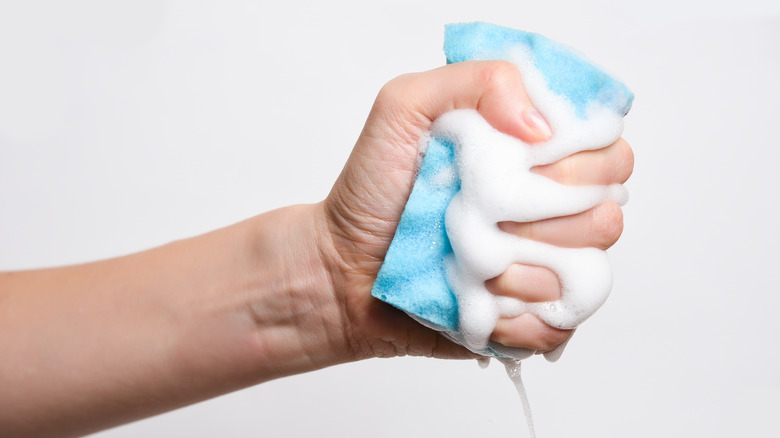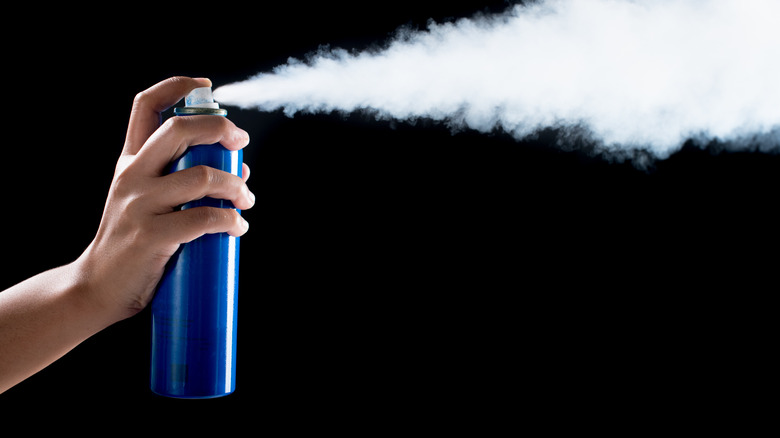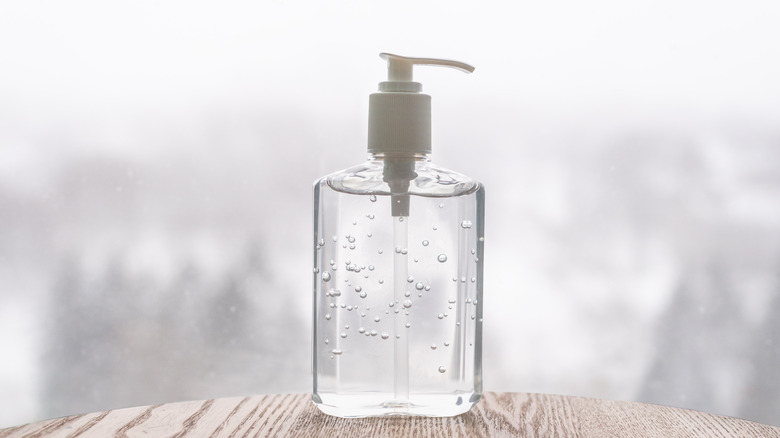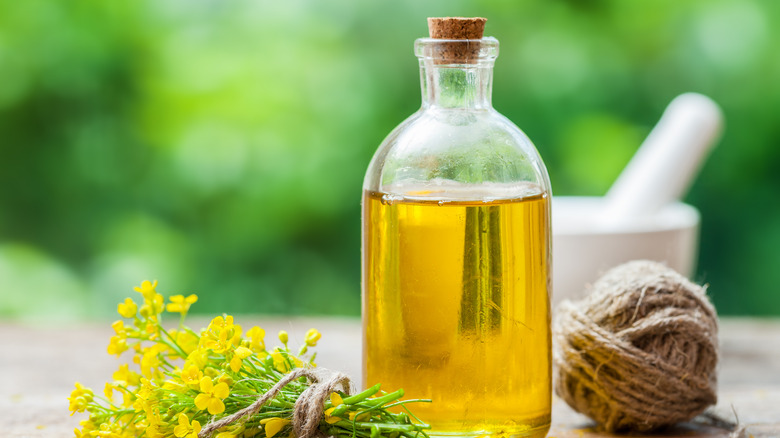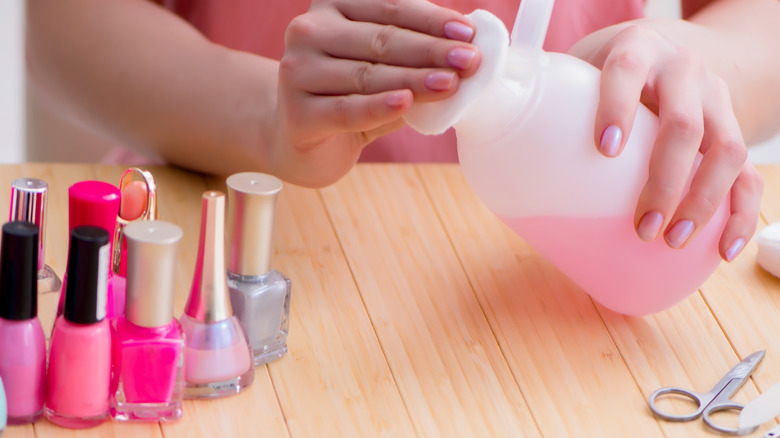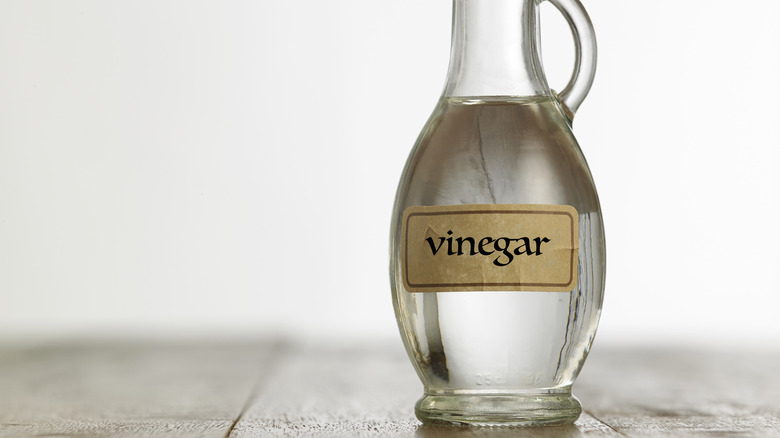8 Best Ways To Get Rid Of Permanent Marker Stains In Your House
Many people have a few permanent markers stashed away in a drawer somewhere in their house. Perhaps you haven't used them since the last time you scrawled room names and items on cardboard boxes when you moved, or maybe you have one tucked away in your kitchen to label items destined for the freezer. Either way, they can be a great writing implement — that is, until the ink gets on something and you just can't get it out. Whether you dropped the marker while hastily scrawling or a child went rogue and doodled all over your walls, it can be extremely frustrating and difficult to remove permanent marker stains because, well, they're supposed to be permanent — those pigments really soak into whatever they're on, per Good Housekeeping. However, the name is somewhat misleading, because you don't have to immediately abandon all hope when faced with a marker stain from this particular writing implement.
Before you rush to the hardware store for a fresh gallon of paint to splash on the damaged walls, or hit your favorite furniture store to replace a ruined armchair, you may want to consider trying out these tips to get rid of permanent marker stains. They just might save that scribbled-on surface or furniture piece, and many of them use common ingredients that you might even have at home already.
1. Baking soda
Often, one of the most challenging parts of removing stains is simultaneously protecting the item you're trying to save. After all, you can splash some seriously harsh chemicals on a piece of furniture and remove a stain, but you may be left with an equally unsightly end product if the chemical reacts with the fabric of that couch cushion. That's why this hack is so great — and it couldn't be simpler.
If you get a permanent marker stain on something like an armchair, couch, or other piece of upholstered furniture, all you need to do in order to try removing it is to sprinkle baking soda over the stain, according to Family Handyman. Then, you take a toothbrush and just scrub, scrub, scrub away. You may have to repeat the process a few times, and you'll need to bring some patience (and elbow grease) to the table. However, given that baking soda is gentle enough to consume, it's a good option if you're worried about harsher removing agents potentially damaging the item you're trying to remove the stain from.
2. Dry erase marker
It may seem incredibly counterintuitive to remove a marker stain by adding another marker stain to the equation. After all, aren't you just making things even harder for yourself in the end? Well, not exactly — not if you use a dry erase marker. This hack is particularly well-suited for permanent marker stains on stainless steel appliances or whiteboards, as noted by Family Handyman. After all, who hasn't grabbed a permanent marker instead of a whiteboard marker at some point and scrawled something, not realizing the error until it's too late?
All you need to do for this tip is to color over the permanent marker stain with the whiteboard marker, and then the two should react in a way that allows you to just wipe away the stain relatively easily. And while many cleaning hacks say to allow the materials to soak for a while, in this case, you want to get erasing while the dry erase marker is still wet for best results (via Cleanipedia).
3. Dish soap, vinegar, and rubbing alcohol
When you're confronted with an awful, potentially permanent stain somewhere in your home, the last thing you want to do is run to the store for additional supplies to try to remove it — that's why this hack is so useful. Most individuals likely have some dish soap in their kitchen and vinegar in their pantry. For this hack, all you need to do is mix a tablespoon of the liquid dish soap with a tablespoon of white vinegar and about two cups of cold water, says Good Housekeeping.
After your cleaning solution has been stirred and is all combined, you can gently dab a sponge dampened with the liquid onto your stain. You want to allow the liquid to soak into the stain for 30 minutes at minimum, and make sure to blot every few minutes. Then you can switch to rubbing alcohol until the stain has completely disappeared, at which point you'll blot the area with a sponge soaked in just water to try to rinse out all those added liquids.
4. Hairspray
When it comes to cleaning solutions found in your bathroom, your first thought probably wouldn't be on your beauty products — but there's one in particular that you shouldn't overlook: simple hairspray, the same product you use to ensure your hair looks fabulous all day long or stays sleek for a special event. Many inexpensive hairsprays have a relatively high alcohol content, which makes them a solid stain remover, per Grove.
Thanks to the handy aerosol applicator, you can just generously spray the stained area with the hair tamer until it's fairly saturated, let it sit for a few minutes, and then dab away until you start to eliminate that stain. When you're satisfied with how the stain (or hopefully former stain) is looking, you'll want to rinse the fabric with cold water in order to get all that hairspray out of the item and avoid any sticky, unpleasant residue. The one thing to consider is that the alcohol content can be a bit harsh on more delicate fabrics and textiles. Thus, this trick is better for fabrics that are a bit tougher, or made from materials like polyester.
5. Hand sanitizer
Do you still have bottles and bottles of hand sanitizer stashed away in every corner of your house, just in case? Well, you're in luck — they could be just what you need if you're faced with a young Picasso who has gotten a little too enthusiastic with permanent marker all over your walls, according to Cleanipedia.
When it comes to removing stains, one of the first things you have to consider is the material you're working with, and which solutions are best suited to that specific area. If you're removing a very large stain or a stain from a highly conspicuous area, you may want to do a little test patch to ensure your paint doesn't end up coming off along with the stain. Once you're feeling reassured, all you need to do is cover the permanent marker stains with the hand sanitizer in a thin layer, and then scrub, scrub, scrub until the stain is gone. It may take a little elbow grease, but you should be back to your beautifully painted wall in no time.
6. Vegetable oil
So, your child managed to get their hands on a permanent marker and opted to spruce up your kitchen by scribbling all over your laminate countertops. Not an ideal situation — but luckily, there's one super common ingredient likely sitting in your pantry right now that can help. We're talking about plain old vegetable oil, as noted by Family Handyman.
All you need to do for this hack is dab a small point of vegetable oil onto a paper towel, then place the oily towel over top of the stain. After allowing the towel to soak for a few minutes, you can take a fresh towel and scrub away at that hopefully-loosened pigment until the stain is gone. Obviously, you'll want to clean away all that oily residue, so you need to follow up this particular hack with a good old soap and water cleanse as well. Then, hopefully, you'll be able to return to your fresh, stain-free kitchen countertops.
7. Nail polish remover
Another tip that uses an item you likely have sitting around in your bathroom cabinets, nail polish remover, can be a great way to get stains out of fabric like cotton, suggests Reader's Digest. Nail polish remover contains alcohol as well as acetone, both of which can be very useful at dissolving substances. After all, if your nail polish remover is able to strip away your three layers of glitter polish, it can surely remove a small flick of black permanent marker on your favorite cotton-clad armchair, right?
While you may be able to pour some solutions directly onto your furniture or housewares in order to remove a particular stain, with this substance you don't want to apply it directly — you'll need to saturate a textile like a cloth, a cotton ball, or a paper towel, and then gently dab the stain with your damp textile. You can then take a clean cloth and continue to gently dab, soaking up some of that nail polish remover and hopefully some of the stain. You can repeat the process as many times as you need in order to return your piece of furniture to its previous stain-free glory.
8. Regular white vinegar
White vinegar features in combination with other items in some hacks, but it can also be incredibly effective all on its own. This cleaning tip is perfect for when you're faced with permanent marker stains on a leather surface of some sort, whether it's a couch, armchair, or simply a favorite leather tray you use to accessorize your entryway. The reason that this particular method should be your first stop when a leather item becomes stained is that many harsher substances that can be used to remove stains contain alcohol, which can be damaging to leather, per Reader's Digest.
All you need to do for this method is to saturate a cloth, cotton ball, or paper towel with white vinegar, and dab a generous amount on the stain. Let the vinegar soak into the stain for about five minutes, then gently dab to try to remove some of the ink — and repeat until you're satisfied.
